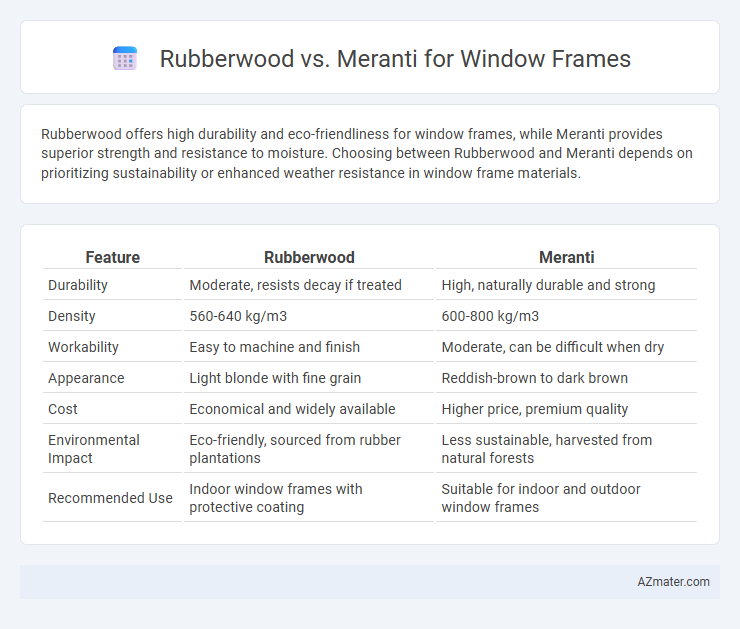Rubberwood offers high durability and eco-friendliness for window frames, while Meranti provides superior strength and resistance to moisture. Choosing between Rubberwood and Meranti depends on prioritizing sustainability or enhanced weather resistance in window frame materials.
Table of Comparison
| Feature | Rubberwood | Meranti |
|---|---|---|
| Durability | Moderate, resists decay if treated | High, naturally durable and strong |
| Density | 560-640 kg/m3 | 600-800 kg/m3 |
| Workability | Easy to machine and finish | Moderate, can be difficult when dry |
| Appearance | Light blonde with fine grain | Reddish-brown to dark brown |
| Cost | Economical and widely available | Higher price, premium quality |
| Environmental Impact | Eco-friendly, sourced from rubber plantations | Less sustainable, harvested from natural forests |
| Recommended Use | Indoor window frames with protective coating | Suitable for indoor and outdoor window frames |
Introduction to Rubberwood and Meranti
Rubberwood, derived from the Para rubber tree (Hevea brasiliensis), is a sustainable hardwood known for its light color, fine grain, and durability, making it a popular choice for window frames in tropical climates. Meranti, sourced primarily from Shorea species native to Southeast Asia, features a reddish hue, medium density, and excellent resistance to decay, offering robust performance for exterior window frames. Both woods balance affordability and strength, but rubberwood's plantation origin and uniform texture contrast with Meranti's natural hardwood characteristics and greater weather resistance.
Origin and Availability of Rubberwood and Meranti
Rubberwood, primarily sourced from Southeast Asian countries like Malaysia and Indonesia, is a sustainable hardwood derived from rubber trees after latex production ends, promoting eco-friendly utilization. Meranti, native to the tropical rainforests of Malaysia, Indonesia, and the Philippines, is readily available but faces sustainability concerns due to slower growth and overharvesting. Both woods are widely accessible in Southeast Asian markets, though rubberwood's plantation-based origin ensures more consistent supply and environmental benefits for window frame manufacturing.
Physical Properties Comparison
Rubberwood offers moderate hardness with a Janka hardness rating of approximately 980 lbs, making it durable but less dense compared to Meranti, which ranges between 720-1120 lbs depending on species variation. Rubberwood exhibits a uniform texture and lighter color with a density of about 560 kg/m3, while Meranti has higher density values often exceeding 600 kg/m3 and displays a more varied grain pattern and reddish-brown hues. In terms of moisture resistance, Meranti tends to perform better in humid conditions due to its natural durability and moderate resistance to decay, whereas Rubberwood requires proper treatment to enhance its resistance to moisture and insect attacks.
Durability and Longevity
Rubberwood offers moderate durability with resistance to warping and decay, making it suitable for window frames in stable indoor environments but may require treatment for outdoor use. Meranti is known for its higher durability and natural resistance to moisture and pests, providing enhanced longevity in both indoor and outdoor window applications. Choosing Meranti typically ensures longer-lasting window frames with better resistance to environmental stress compared to Rubberwood.
Resistance to Pests and Decay
Rubberwood offers moderate resistance to pests and decay but requires proper treatment and sealing to enhance its durability for window frames. Meranti is naturally more resistant to termites and decay, making it a preferred choice for long-lasting exterior applications in tropical climates. Both woods benefit from preservative treatments to ensure optimal performance against moisture and insect damage.
Aesthetic Appeal and Grain Patterns
Rubberwood window frames exhibit a light, creamy color with a subtle, straight grain pattern that enhances modern and minimalist interiors, while Meranti offers a richer reddish-brown hue with pronounced, wavy grain patterns, providing a more traditional and luxurious aesthetic. The uniform texture of Rubberwood allows for smooth finishes and paint absorption, making it ideal for contemporary designs, whereas Meranti's distinctive grain and natural luster emphasize richness and visual warmth in classic window frames. Both woods balance durability with aesthetic appeal, but Meranti's grain complexity often serves as a standout feature in ornate or heritage-style windows.
Workability and Ease of Fabrication
Rubberwood offers superior workability and ease of fabrication for window frames due to its fine, even grain and consistent density, allowing for smooth cutting, sanding, and joining. Meranti, while durable, typically has a coarser texture and uneven grain, which can cause difficulty in machining and finishing processes. The lower resin content in Rubberwood also reduces tool wear, making it a preferred choice for intricate window frame designs.
Environmental Impact and Sustainability
Rubberwood, derived from rubber trees harvested after latex production, is highly sustainable due to its use of plantation-grown resources and efficient carbon sequestration during growth. Meranti, often sourced from natural tropical forests, raises environmental concerns related to deforestation and habitat loss, especially when illegally logged or unsustainably managed. Choosing rubberwood for window frames supports eco-friendly practices and reduces the carbon footprint compared to Meranti, which may contribute to biodiversity decline and ecosystem degradation.
Cost Comparison and Value for Money
Rubberwood window frames offer a more affordable option compared to Meranti, with prices generally ranging between $15 to $25 per linear foot, making them ideal for budget-conscious projects. Meranti frames, priced higher at approximately $30 to $45 per linear foot, provide superior durability and natural resistance to moisture and insects, justifying the additional investment for long-term value. Choosing Rubberwood balances cost efficiency and eco-friendliness, while Meranti delivers enhanced strength and longevity, making it a better value for premium window frame applications.
Which is Better for Window Frames?
Rubberwood offers excellent durability, resistance to warping, and a smooth finish, making it a preferred choice for window frames in humid climates. Meranti provides good strength and is more affordable but is prone to moisture absorption and potential rotting over time. For long-lasting, stable window frames, Rubberwood is generally better due to its superior moisture resistance and structural integrity.

Infographic: Rubberwood vs Meranti for Window Frame
 azmater.com
azmater.com